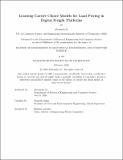Learning Carrier Choice Models for Load Pricing in Digital Freight Platforms
Author(s)
Li, Alexandra
DownloadThesis PDF (3.702Mb)
Advisor
Amin, Saurabh
Terms of use
Metadata
Show full item recordAbstract
With the expansion of digital commerce and growth of the economy, the freight transportation scene has adapted to reflect such changes. Digital freight platforms, acting an intermediary between shippers and carriers, have gained traction to modernize the process and leverage technology to improve efficiency and increase the ease-of-use for all parties involved. Through their role in setting prices and presenting loads, these platforms can reduce the negative environmental impact of freight while simultaneously increasing the efficiency of carriers and satisfying the needs of shippers. The key challenge that these digital freight platforms face is understanding how carriers strategically select an action on the platform, which is difficult to capture despite having large amounts of data because naive estimation methods on historical data produce unrealistic results for different pricing methods.
This thesis addresses this challenge by developing a simulation to evaluate the practicality of these estimates and iteratively revise the parameters based on constraints until they produce desirable results. In our research, we model the behavior through which carriers select a load to accept or reject with a 2-way latent class multinomial logit model. We tune the parameters of this model through a feedback loop where we perform a maximum likelihood estimate on the data to obtain model parameters, evaluate these parameters in the simulation, and use the results to perform a re-estimation to eventually obtain parameters that are both representative of the data and produce the expected results.
We use this system to evaluate optimized pricing and load presentation methods. We experiment with bundling, or grouping a sequence of loads together to reduce the overhead time carriers spend finding suitable loads and to produce routes with less CO2 emissions. We solve for a mixed-integer linear program that maximizes the total utility of bundles proposed by the platform to generate few and non-overlapping bundles. We develop a dynamic programming based pricing method to generate carrier and time specific prices for bundles. We evaluate these methods in our model and analyze the effects of such methods on carrier interactions and behavior. Although these methods do not yet show a substantial decrease in freight carbon emissions, we have laid the groundwork for modeling this complex system and hope that future work can be done to reduce the negative environmental that the freight transportation sector leaves on this planet.
Date issued
2024-02Department
Massachusetts Institute of Technology. Department of Electrical Engineering and Computer SciencePublisher
Massachusetts Institute of Technology